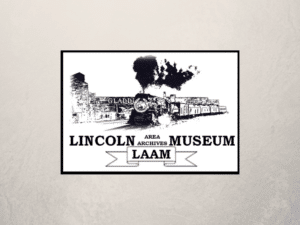Stories Out of the Archives
Posted on: January 3, 2019, by : Cherie Weygandt
Lincoln’s Renaissance , 1873-1880
“October 11, 1873, Coal Mine in Placer. – We learn from a friend that a bed of coal has been discovered in Lincoln in this county, which promises to be of great importance, not alone to that section, but to the whole country. The same material was struck as early as 1862, while boring a well, but it attracted no attention, as no one seemed to suspicion the existence of coal in that part of the country.”
Newspaper reports of coal induced Charles Lincoln Wilson to do test boring at various sites on the north side of town. He finally settled on a location at the north end of F Street. The coal was 58 feet down in a 13-foot thick layer. On December 27, 1873, the Lincoln Coal Mine was reported open and shipping coal by rail.
Another report about the coal in Lincoln ended: “If it is a good thing, as we hope it is, the people of Lincoln will soon have to commence repairing some of those shabby-looking houses which line the streets of that moral little burg.”
The spirits of the townspeople began to rise with the prospect of jobs in the coal mine and in shipping it via the railroad and in the resulting increase of activity in the businesses in Lincoln. In May 1874: “We passed through Lincoln the other day and were pleased to notice a marked improvement of the town. Many of the property owners were repairing and painting their buildings, which gives to the place quite an improved appearance to what it was a year ago. The coal does it.”
Property values in Lincoln were rising impressively. There was complaining about the high price of bricks, $20 per 1,000. A side track was completed from the main rail line to the coal mine.
Lincoln coal was found to do well in iron smelting. It was tested in Sacramento at Guttenberg’s foundry. Housewives found it excellent for the kitchen stove.
An unexpected outcome of coal mining proved to be more crucial to Lincoln’s future than the coal itself. As the layer of coal was being removed, observers noted that the ceiling of the resulting tunnel was composed of clay, apparently of very high quality. Other parties prospecting for coal north of town had also noticed layers of clay above the coal.
Charles Gladding, operator of a pottery in Chicago, read a report about the clay in Lincoln. He visited the site in February of 1875 and had large samples of the clay tested in Oakland and San Francisco and also at his pottery in Chicago. Satisfied with its superior quality he formed a company with Peter McBean and George Chambers and prepared to move out to California.
In May of 1875, with a total of $12,000 capital invested by the three partners, the building of a pottery at the north end of town was underway. The first clay was hoisted out of the coal shaft. By July they were manufacturing and firing vitrified sewer, water and irrigation pipe (Iron Stone).
The original name, California Clay Manufacturing Company, soon became Gladding, McBean & Co.
………………………..and the rest is history.
For the complete story: this article is found in the Lincoln Area Archives publication “Lincoln Area History Review – Indian Era to 1980”, Chapter 15, written by Lincoln Historian Jerry Logan. This book is available at the Lincoln Gift Shop.
